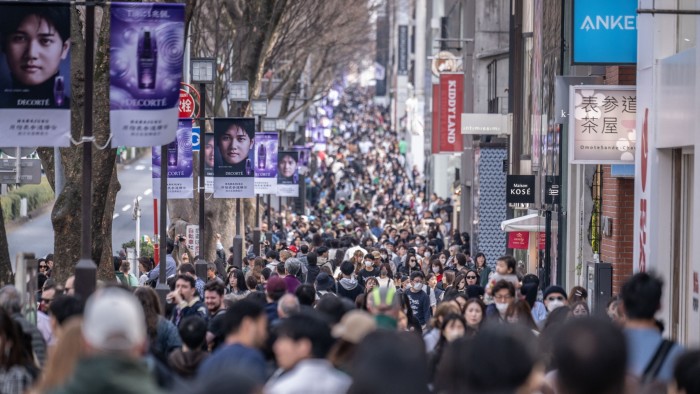Unlock the Editor’s Digest for free
Roula Khalaf, Editor of the FT, selects her favourite stories in this weekly newsletter.
Japan’s core inflation rate climbed at its fastest rate in more than two years in April, piling pressure on the Bank of Japan as it seeks to normalise the country’s interest rates and the unpopular government of Prime Minister Shigeru Ishiba.
Core inflation, which excludes fresh food but includes energy prices, rose 3.5 per cent on a year earlier last month, official data showed on Friday, exceeding the 3.2 per cent pace of growth in March and the fastest rate since January 2023.
An accompanying “core-core” index, which also strips out energy, rose 3 per cent in April from a year earlier.
The acceleration came as Japan began its financial year in April, a period that often prompts price rises at restaurants, private schools and entertainment services. But it underscored the challenges confronting the BoJ and Ishiba’s administration, which has seen little progress towards a deal with the US to avert President Donald Trump’s high tariffs.
The yen strengthened 0.4 per cent on Friday to ¥143.47 per US dollar. The Topix equities benchmark rose 0.7 per cent and the exporter-oriented Nikkei 225 index climbed 0.5 per cent.
Yields on 10-year Japanese government bonds shed 0.015 percentage points to 1.549 per cent, while those on the 40-year bonds declined 0.05 percentage points to 3.624 per cent after touching record highs earlier in the week. Bond yields move inversely to prices.
JGB yields rose to record highs this week, alarming economists, before ending the week relatively calm. But traders in Tokyo warned that the inflation numbers would intensify market focus on Japan’s economic challenges.
Krishna Bhimavarapu, Asia-Pacific economist at State Street Global Advisors, said the “firm” inflation reading could “augment the turbulence in JGBs [at] the long end”.
“While the BoJ is rightly taking a patient approach, the upshot is a lesser than expected tax cut, which maintains high inflation that could lower consumption and slow the economy,” he added. “Suddenly the risks to the economy got quite real.”
But Marcel Thieliant, Japan economist at Capital Economics said that despite dovish comments this week from senior BoJ officials, Friday’s CPI figures suggested that the central bank remained on track for further “normalisation” of monetary policy.
“This has increased our confidence that a BoJ hike will come this year,” he said, adding that headline inflation, which was at 3.6 per cent for April, meant that a rate rise “will come sooner rather than later.”
Thieliant predicted that a rise at the central bank’s October policy meeting appeared more realistic than at its July gathering, as many analysts had earlier forecast.
The core consumer price index includes rice, a politically sensitive staple for millions of Japanese households. Despite government measures aimed at lowering prices, including dipping into the national strategic reserve earlier this year, rice prices in April were almost 99 per cent higher than in 2024.
The start of the new financial year in April 1 triggered a wide range of further price increases, analysts said. In a survey of major food producers, research company Teikoku Databank found that the cost of about 4,000 food items climbed in April.
Goldman Sachs economists also pointed to broad price rises in April in dining-out venues, private tuition fees and entertainment services but noted that costs were often raised by service industries in that month.
April’s core CPI was also pushed higher by the end of government subsidies for gas and electricity, observers said, but many households also benefited from the gradual introduction of free high school tuition in April, which mostly affected the families of children at state schools.
Additional reporting by William Sandlund in Hong Kong

